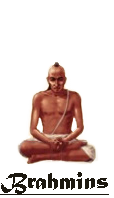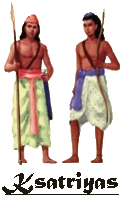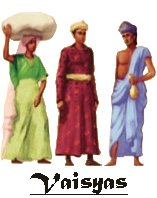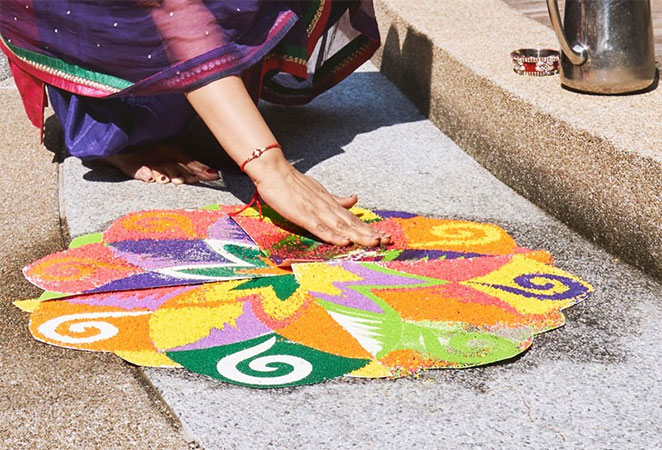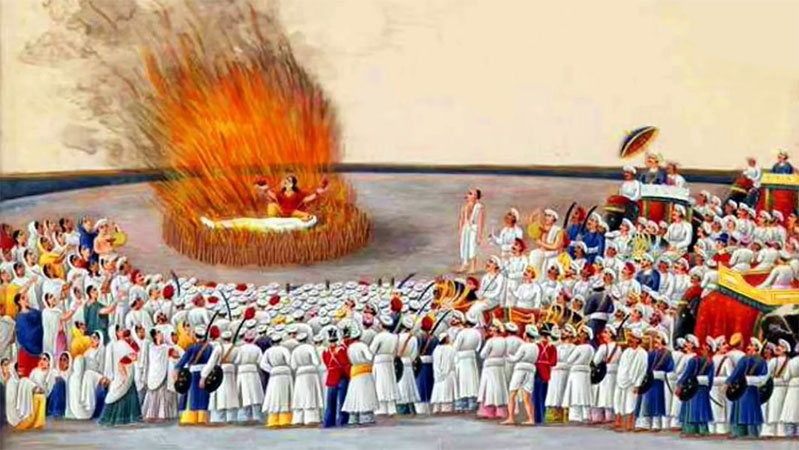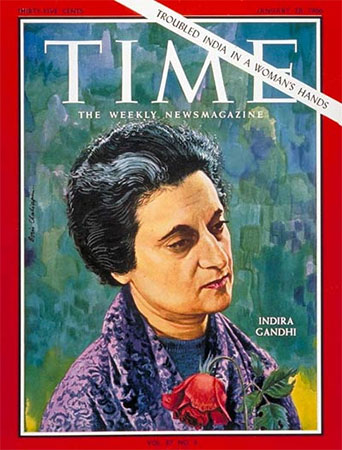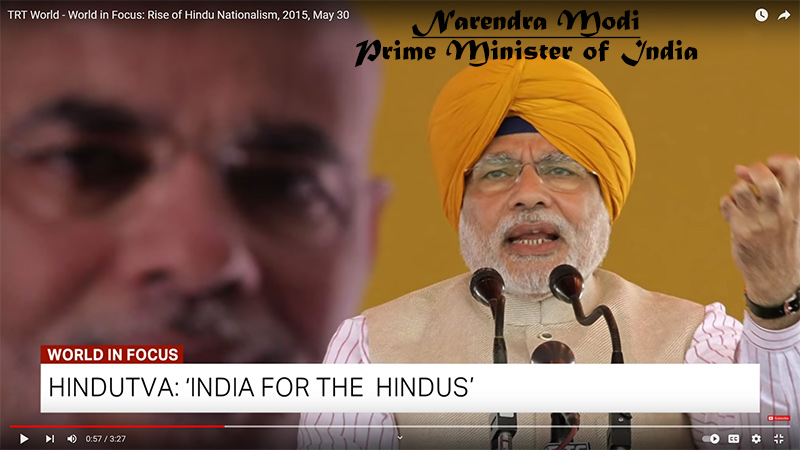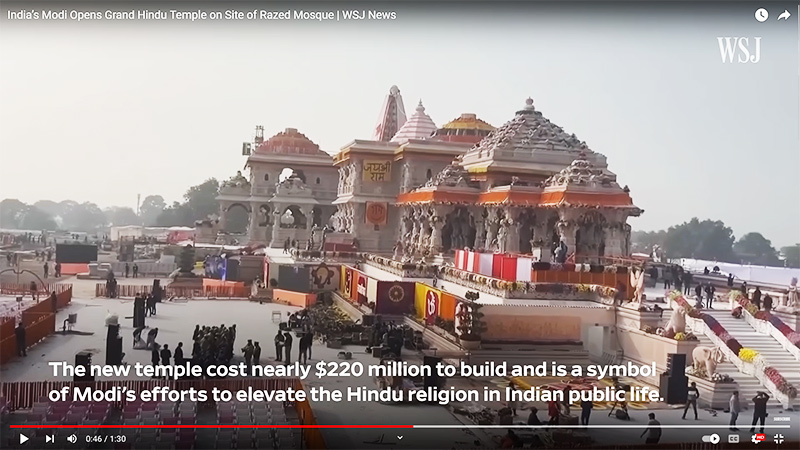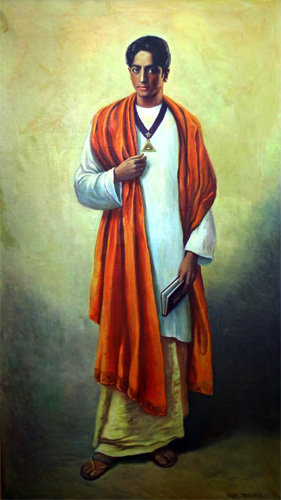The Varnas seem to date back to the Vedic age. ... Over time,
Vedic religion was increasingly controlled by the Brahmins,
and contact between castes was limited. Varna membership became
hereditary. The
caste system became a significant aspect of Indian life, although many
Hindus questioned its rules, particularly with respect to spiritual
capabilities. Many medieval bhakti poets of low caste challenged the
restrictions that kept them out of temples, asserting that the gods
accepted sincere devotion even from those of the lowest status. Since
the nineteenth century, many Hindu leaders and groups have challenged
and rejected caste distinctions. Mahatma Gandhi renamed the lowest caste Harijans,
“the children of God.” Finding this designation condescending, a
segment of this population who are pressing for better status and
opportunities now refer to themselves as Dalits (oppressed).
Caste
&Jati
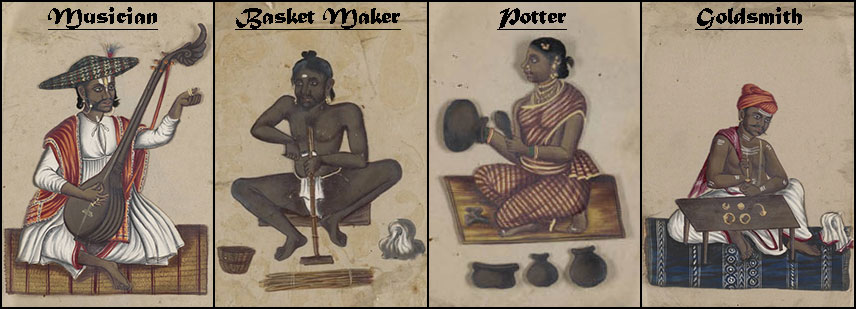
In 1948 the stigma of “untouchability” was
legally abolished, though many caste distinctions still linger in
modern India. Marriage across caste lines, for instance, is still
usually disapproved of and families typically try to maintain Jati endogamy when arranging marriages. ... The division of labor
represented by the Varnas is part of Hinduism’s strong emphasis
on social duties and sacrifice of individual desires for the sake of
social order. The Vedas, other scriptures, and historical customs have all conditioned the Indian people to accept their social roles.
These were set out in religious-legal texts such as the Code of Manu,
compiled 100-300 CE. In it are laws governing all aspects of life,
including the proper conduct of rulers, dietary restrictions, marriage
laws, daily rituals, purification rites, social laws, and ethical
guidance. It prescribed hospitality to guests and the cultivation of
such virtues as contemplation, truthfulness, compassion, nonattachment,
generosity, pleasant dealings with people, and self-control. It
condemned “untouchables” to living outside villages, eating only from
broken dishes. On the other hand, the code proposed charitable giving
as the sacred duty of the upper castes, and thus provided a safety net
for those at the bottom of this hierarchical system. (Living Religions, 93-5)
 |
Mahatma Gandhi on Caste
I
do not believe in caste in the modern sense. It is an excrescence and a
handicap on progress. Nor do I believe in inequalities between human
beings. We are all absolutely equal. But equality is of souls and not
bodies. ... We have to realize equality in the midst of this apparent
inequality. Assumption of superiority by any person over any other is a
sin against God and man. Thus caste, in so far as it connotes
distinctions in status, is an evil. I do however believe in varna which
is based on hereditary occupations. Varnas are four to mark four
universal occupations —
imparting knowledge, defending the defenseless, carrying on agriculture
and commerce, and performing service through physical labor. These
occupations are common to all mankind, but Hinduism, having recognized
them as the law of our being, has made use of it in regulating social
relations and conduct. Gravitation affects us all whether one knows its
existence or not. But scientists who knew the law have made it yield
results that have startled the world. Even so has Hinduism startled the
world by its discovery and application of the law of varna. (academia.edu/326347...)

|
Is the caste system just?
 How is "race" in America similar to and/or different from "caste" in India?
How is "race" in America similar to and/or different from "caste" in India?
 The Status of Women
The Status of Women
At the level of
spiritual ideals, the female is highly venerated in Hinduism, compared
to many other religions. Women are thought to make major contributions
to the good earthly life, which includes dharma
(order in society), marital wealth (by bearing sons in a patriarchal
society), and the aesthetics of sensual pleasure. ...
Women were not
traditionally encouraged to seek liberation through their own spiritual
practices. A woman’s role is usually linked to that of her husband, who
takes the position of her god and teacher. For many centuries, there
was even the hope that a widow would choose to be cremated alive with
her dead husband in order to remain united with him after death.
In early Vedic times, women were relatively
free and honored members of Indian society, participating equally in
important spiritual rituals. But because of social changes, by the
nineteenth century wives had become like servants of the husband’s
family. With expectations that a girl will take a large dowry to a
boy’s family in a marriage arrangement, girls are such an economic
burden that female babies may be intentionally aborted or killed at
birth. There are also cases today of women being beaten or killed by
the husband’s family after their dowry has been handed over — an atrocity that occurs in various Indian communities, not only among Hindus. (Living Religions, 106-7)
The Widows of Vrindavan
Widows
in India no longer throw themselves on the funeral pyres of their
husbands. But life for them can still be hard. Considered inauspicious,
many soon find they have lost their income and are ostracised in their
home villages. Some are sent away by their husbands’ families who want
to prevent them inheriting money or property. ...
Some come [to Vrindavan] as genuine pilgrims to devote their remaining years to the
service of Radha/Krishna, but many others come here to escape from
brutal family homes or have been flung out by their sons and
daughters-in-law as unwanted baggage. This is one unusual aspect
of Indian society that the government might prefer the outside world not
to see, despite all their genuine efforts to solve the problem. (bbc.com/news/magazine-21859622) |
How might the concept of karma influence the treatment of women in India?
 Is this a problem with Hinduism or is it primarily due to other social forces?
Is this a problem with Hinduism or is it primarily due to other social forces?

|
| Nevertheless, many women in contemporary
India have been well educated, and many have attained high political
positions. As in the past, women are also considered essential to the
spiritual protection of their families, for they are thought to have
special connections with the deities. Married women carry on daily
worship of the deities in their homes, and also fasts and rituals
designed to bring good health, prosperity, and long life for their
family members. (Living Religions, 107) |
How will the forces of modernity transform Hinduism?
|
 Exclusivism & Inclusivism
Exclusivism & Inclusivism
Competing Visions of Contemporary Hinduism


|
Hindutva
Hindu Nationalism & the Destruction of the Babri Mosque
The galvanizing event in the recent history of religion in India was the destruction of the so-called Babri Mosque in Ayodhya,
a sleepy pilgrimage town on the Gangetic Plain southeast of Delhi.
There, on December 6, 1992, Hindu militants pulled down a Mughal mosque
stone by stone as two hundred thousand people watched and cheered. They
were clearing the ground for a massive temple to Rama on the site they
believe to be this god’s birthplace — a site, therefore, where no mosque
ever belonged. ...
Turmoils
at Ayodhya have had a way of coinciding with major political shifts.
Confrontations between groups of Hindus and Muslims shortly preceded
the British takeover of that part of India in 1856 and again followed
the great anti-British revolt of 1857. About a century later, in 1949,
soon after the British had “quit India” and the subcontinent had
suffered a bloody partition into the sister states of India and
Pakistan, an image of Rama suddenly appeared inside the precincts of
the mosque. Heralded as a miracle by some and as a hoax by others, this
event led to a long moratorium in which the mosque/temple was closed to
worship, by court order. When judges opened the doors again in 1986,
the struggle intensified, this time primarily under the pressure of a
massive campaign waged by the Vishwa Hindu Parishad (VHP, or World Hindu Council), a group with close ties to the major instrument of Hindu nationalism in India today, the Bharatiya Janata Party (BJP).
The
BJP depicted itself to voters across India and to expatriates around
the world as the one force capable of rescuing India from the
long-ruling Congress Party’s policies of socialism, unbalanced
secularism, slavish submission to the demands of minorities, and
general corruption. The BJP portrayed itself as the superior party on
two fronts. First, it was clean and efficient — a claim that enjoyed
somewhat greater credence before the BJP actually acceded to rule in
several states. Second, it was a party with a central agenda, and an
agenda about a center. That center was Hinduness (hindutva),
a concept it borrowed from Hindu groups who had been active since the
early decades of this century. The BJP filled out the concept by giving
it a physical focus: it held up Ayodhya as the symbolic center of Hindu
life. Ayodhya was depicted as the ideal city, the city where the god
Rama had watched over his golden-age kingdom (ram rajya).
As the divine exemplar of sovereignty, Rama himself was to be India’s
ruler again, with the BJP (and implicitly sister groups such as the
VHP) as his chief instruments of power.
The
problem as the BJP saw it was that Ayodhya, once a truly sacred center,
had been defiled. Its most massive building was now a mosque, a
structure representative of a polity and religion that the BJP and VHP
depicted as belonging to an invader — politically Mughal, religiously
Muslim. The mosque must go if India was to recover the sacred core of
its identity. A new temple marking Rama’s birthplace would supplant
it. ... Toward
the end of 1990, drama yielded to confrontation as the BJP and its
allies sent the first “troops” to attack the mosque itself. Tens of
thousands of activists massed, and six of them were killed by police in
the fray. Instantly, they became martyrs. From then onward clouds
gathered thickly as electoral struggles intensified — there were major
BJP victories at the polls in 1991 — and at the end of 1992 another
major thrust against the mosque was organized. This time hundreds of
thousands of militants flooded into Ayodhya, camping in regional groups
and often in settings prepared with near-military precision. December 6
was the day announced for attack (“liberation”), and a flurry of
last-minute measures involving the provincial and central governments
and the judiciary ultimately did nothing to deflect it. To many
people’s surprise — and horror — the government failed to intervene in
any decisive way. In five hours’ time the mosque came down, its three
great domes crashing into a dusty sea of rubble. (The Life of Hinduism, 257-9)
|

 |
Hindu Universalism
Jiddu Krishnamurti
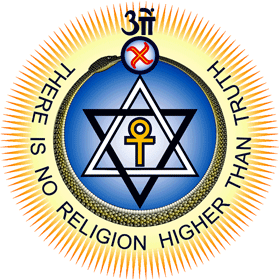 Jiddu
Krishnamurti was born in 1895 in the town of Madanapalle in the
hill-country of southern Andhra Pradesh. His father, a struggling
clerk, was a member of the Theosophical Society. After his retirement,
he took Krishna and three of his other children to the society’s
headquarters in Chennai, where he had found employment.
Soon after their arrival, C. W. Leadbeater, a prominent Theosophist,
became
convinced that Krishna was meant to be the vehicle of the World Teacher
that
he and his colleagues were awaiting. Soon Krishna had been adopted by
Annie
Besant, the President of the Theosophical Society, who became his legal
guardian. In 1911 an organisation called the Order of the Star in the
East was founded with Krishna at its head. The same year he was taken
to England, where he lived for the next ten years. Tutored by members
of the Society, he grew
up in an atmosphere charged with occult mysteries. He also received a
conventional education, but repeatedly failed his examinations. Jiddu
Krishnamurti was born in 1895 in the town of Madanapalle in the
hill-country of southern Andhra Pradesh. His father, a struggling
clerk, was a member of the Theosophical Society. After his retirement,
he took Krishna and three of his other children to the society’s
headquarters in Chennai, where he had found employment.
Soon after their arrival, C. W. Leadbeater, a prominent Theosophist,
became
convinced that Krishna was meant to be the vehicle of the World Teacher
that
he and his colleagues were awaiting. Soon Krishna had been adopted by
Annie
Besant, the President of the Theosophical Society, who became his legal
guardian. In 1911 an organisation called the Order of the Star in the
East was founded with Krishna at its head. The same year he was taken
to England, where he lived for the next ten years. Tutored by members
of the Society, he grew
up in an atmosphere charged with occult mysteries. He also received a
conventional education, but repeatedly failed his examinations.
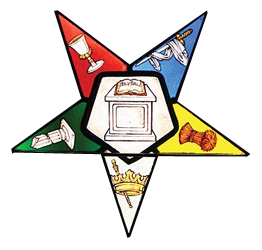
 |
Truth is a Pathless Land
August 2, 1929
We are
going to discuss this morning
the dissolution of the Order of the Star. Many people will be
delighted,
and others will be rather sad. It is a question neither for rejoicing
nor
for sadness, because it is inevitable, as I am going to explain.
You may remember the story of how the devil and a
friend of his were walking down the street when they saw ahead of them
a man stoop down and pick up something from the ground, look at it, and
put it away
in his pocket. The friend said to the devil, “What did that man pick
up?”
“He picked up a piece of Truth,” said the devil. “That is a very bad
business for you, then,” said his friend. “Oh, not at all,” the devil
replied, “I
am going to let him organize it.”
I maintain that Truth is a pathless land, and you
cannot approach it by any path whatsoever, by any religion, by an sect.
That is
my point of view, and I adhere to that absolutely and unconditionally.
Truth, being limitless, unconditioned, unapproachable by any path
whatsoever, cannot be organized; nor should any organization be formed
to lead or to coerce
people along any particular path. If you first understand that, then
you
will see how impossible it is to organize a belief. A belief is purely
an
individual matter, and you cannot and must not organize it. If you do,
it
becomes dead, crystallized; it becomes a creed, a sect, a religion, to
be
imposed on others. That is what everyone throughout the world is
attempting
to do. Truth is narrowed down and made a plaything for those who are
weak,
for those who are only momentarily discontented. Truth cannot be
brought
down; rather, the individual must make the effort to ascend to it. You
cannot
bring the mountaintop to the valley. If you would attain to the
mountaintop
you must pass through the valley, climb the steeps, unafraid of the
dangerous
precipices. ...
You want to have your own gods — new gods instead of
the old, new religions instead of the old, new forms instead of the
old — all equally valueless, all barriers, all limitations, all crutches.
Instead of old spiritual distinctions you have new spiritual
distinctions, instead of old worships you have new worships. You are all
depending for your spirituality on someone else, for your happiness on
someone else, for your enlightenment on someone else; and although you
have been preparing for me for eighteen years, when I say all these
things are unnecessary, when I say that you must put them all away and
look within yourselves for the enlightenment, for the glory, for the
purification, and for the incorruptibility of the self, not one of you
is willing to do it. There may be a few, but very, very few. So why have
an organization?
(www.jkrishnamurti) |
 |

 |









 Jiddu
Krishnamurti was born in 1895 in the town of Madanapalle in the
hill-country of southern Andhra Pradesh. His father, a struggling
clerk, was a member of the Theosophical Society. After his retirement,
he took Krishna and three of his other children to the society’s
headquarters in Chennai, where he had found employment.
Soon after their arrival, C. W. Leadbeater, a prominent Theosophist,
became
convinced that Krishna was meant to be the vehicle of the World Teacher
that
he and his colleagues were awaiting. Soon Krishna had been adopted by
Annie
Besant, the President of the Theosophical Society, who became his legal
guardian. In 1911 an organisation called the Order of the Star in the
East was founded with Krishna at its head. The same year he was taken
to England, where he lived for the next ten years. Tutored by members
of the Society, he grew
up in an atmosphere charged with occult mysteries. He also received a
conventional education, but repeatedly failed his examinations.
Jiddu
Krishnamurti was born in 1895 in the town of Madanapalle in the
hill-country of southern Andhra Pradesh. His father, a struggling
clerk, was a member of the Theosophical Society. After his retirement,
he took Krishna and three of his other children to the society’s
headquarters in Chennai, where he had found employment.
Soon after their arrival, C. W. Leadbeater, a prominent Theosophist,
became
convinced that Krishna was meant to be the vehicle of the World Teacher
that
he and his colleagues were awaiting. Soon Krishna had been adopted by
Annie
Besant, the President of the Theosophical Society, who became his legal
guardian. In 1911 an organisation called the Order of the Star in the
East was founded with Krishna at its head. The same year he was taken
to England, where he lived for the next ten years. Tutored by members
of the Society, he grew
up in an atmosphere charged with occult mysteries. He also received a
conventional education, but repeatedly failed his examinations.

